Research on Power Optimization for Energy System of Hydrogen Fuel Cell Wheel-Driven Electric Tractor
Abstract
:1. Introduction
2. Tractor Topology Structure and Main Parameters
2.1. Hydrogen Fuel Cell Wheel-Driven Electric Tractor Topology Structure
2.2. Main Technical Parameters of Hydrogen Fuel Cell Wheel-Drive Electric Tractor
3. Hydrogen Fuel Cell Tractor Model Construction
3.1. Tractor Dynamics Model
3.2. Transmission System Model
3.3. Motor Model
3.4. Power Battery Model
3.5. Hydrogen Fuel Cell Model
3.6. Tyre Model
3.7. Whole-Machine Simulation Model
4. Hydrogen Fuel Cell Tractor Energy System Power Optimization Method
4.1. Equivalent Hydrogen Consumption Model
4.2. Instantaneously Optimized Power Allocation Method Based on Load Demand in the Energy System
5. Simulation Analysis
6. Conclusions
Author Contributions
Funding
Data Availability Statement
Conflicts of Interest
Nomenclature
| B | Stiffness coefficient. |
| C | Curve shape coefficient. |
| CAN | Controller Area Network. It is a serial communication protocol used for communication between electronic control units in the automotive and industrial fields. |
| Cfc | Hydrogen consumption of the fuel cell system (kg/s). |
| Cbat | Equivalent hydrogen consumption of the power battery (kg/s). |
| D | Peak adhesion coefficient. |
| DC/AC | Direct Current-Alternating Current converter. It is a device that transforms a direct current power source (typically the input power) into another voltage, current, or power level of alternating current. |
| DC/DC | Direct Current-Direct Current converter. It is a device that transforms a direct current power source (typically the input power) into another voltage, current, or power level of direct current. |
| E | Curve curvature coefficient. |
| EH2,low | Low calorific value of hydrogen (1.2 × 108 J/kg). |
| FC | Fuel cell. |
| Ft | Total driving force (N). |
| Ff | Rolling resistance (N). |
| FTN | Rated traction resistance (N). |
| FTa | Ploughing resistance (N). |
| Fx | Longitudinal force of the tyre (N). |
| i | Speed ratio of the wheel-side reducer. |
| Ibat | Battery current (A). |
| MAP | A graph that describes the performance characteristics of an electric motor. It is usually used to express the relationship between the speed, torque and efficiency of the motor under certain conditions. |
| nq | Required speed of the drive wheels (rpm). |
| nreqm | Required speed of the motor (rpm). |
| PEMFC | Proton Exchange Membrane Fuel Cell. It is a type of fuel cell that uses a proton exchange membrane as the electrolyte. |
| Pbat | Battery power (kw). |
| Pfc | Fuel cell system power (kw). |
| Preqbat | Power battery required power (kw). |
| Preqfc | Fuel cell required power (kw). |
| Preqm | Required driving power of the motor (kw). |
| Qbat | Battery rated capacity (A·h). |
| r | Driving wheel radius (m). |
| Rint | Battery internal resistance (Ω). |
| SV | Vertical drift of the curve. |
| SH | Horizontal drift of the curve. |
| SOC | State of charge. |
| SOCH | Given maximum limit of SOC. |
| SOCL | Given minimum limit of SOC. |
| Tm | Motor torque (N·m). |
| Tq | Torque required for the drive wheels (N·m). |
| Treqm | Required torque of the motor (N·m). |
| v | Tractor velocity (m/s). |
| Voc | Battery open circuit voltage (V). |
| Vfc | Fuel cell output voltage (V). |
| X | Tyre slip rate. |
| Y(x) | Longitudinal force of the tyre (N). |
| α | Linear compensation coefficient. |
| β | Adjustment coefficient. |
| γj | Fitting parameters, j = 1–9. |
| ηdis | Instantaneous discharge efficiency of power battery (%). |
| ηchg | Instantaneous charging efficiency of power battery (%). |
| Average discharge efficiency of power battery (%). | |
| Average charging efficiency of power battery (%). | |
| ηfc | Fuel cell system efficiency (%). |
| ηm | Motor efficiency (%). |
| ξj | Fitting parameters, j = 1, 2, 3, 4. |
References
- Group, C.W. World Energy Outlook 2022. Chem. Wkly. 2022, 68, 165–170. [Google Scholar]
- Technical Committee 4.4 Tunnels. Impact of New Propulsion Technologies on Road Tunnel Operations and Safety—A PIARC Technical Report; The World Road Association: Paris, France, 2023; p. 18. [Google Scholar]
- National Development and Reform Commission. The National Development and Reform Commission issued the “Medium and Long-term Plan for the Development of Hydrogen Energy Industry (2021–2035)”. Rare Earth Inf. 2022, 4, 26–32. [Google Scholar]
- Sulaiman, N.; Hannan, M.; Mohamed, A.; Majlan, E.; Daud, W.W. A review on energy management system for fuel cell hybrid electric vehicle: Issues and challenges. Renew. Sustain. Energy Rev. 2015, 52, 802–814. [Google Scholar] [CrossRef]
- Hassan, F. Novel fuel cell/battery/supercapacitor hybrid power source for fuel cell hybrid electric vehicles. Energy 2018, 143, 467–477. [Google Scholar]
- Zhao, S.; Wang, B.; Xie, Y.H.; Han, M.; Jia, J.B. Linear Temperature Sweep Experimental Study on Proton Exchange Membrane Fuel Cell Without External Humidification. Proc. CSEE 2014, 34, 4528–4533. [Google Scholar]
- Li, Q.; Chen, W.R.; Liu, S.K.; Cheng, Z.L.; Liu, X.Q. Application of Multivariable H∞ Suboptimal Control for Proton Exchange Membrane Fuel Cell Pressure Control System. Proc. CSEE 2010, 30, 123–128. [Google Scholar]
- Zhang, H.; Li, Q.; Wang, H.; Li, Q.; Qin, G.; Wu, Q. A review of energy management optimization based on the equivalent consumption minimization strategy for fuel cell hybrid power systems. Fuel Cells 2022, 22, 116–130. [Google Scholar] [CrossRef]
- Peng, J.K.; He, H.W.; Xiong, R. Rule based energy management strategy for a series–parallel plug-in hybrid electric bus optimized by dynamic programming. Appl. Energy 2016, 185, 1633–1643. [Google Scholar] [CrossRef]
- Lü, X.; Wu, Y.; Lian, J.; Zhang, Y.; Chen, C.; Wang, P.; Meng, L. Energy management of hybrid electric vehicles: A review of energy optimization of fuel cell hybrid power system based on genetic algorithm. Energy Convers. Manag. 2020, 205, 112474. [Google Scholar] [CrossRef]
- Fernandez, A.M.; Kandidayeni, M.; Boulon, L.; Chaoui, H. An Adaptive State Machine Based Energy Management Strategy for a Multi-Stack Fuel Cell Hybrid Electric Vehicle. IEEE Trans. Veh. Technol. 2019, 69, 220–234. [Google Scholar] [CrossRef]
- Shen, Y.; Cui, P.; Wang, X.; Han, X.; Wang, Y.-X. Variable structure battery-based fuel cell hybrid power system and its incremental fuzzy logic energy management strategy. Int. J. Hydrogen Energy 2020, 45, 12130–12142. [Google Scholar] [CrossRef]
- Wen, P.M.; Song, K.; Zhang, T. Energy management strategy of thermostat for fuel cell vehicles based on Pontriagin minimum principle. Mechatronics 2017, 23, 7–12. [Google Scholar] [CrossRef]
- Wang, Y.J.; Sun, Z.D.; Chen, Z.H. Energy management strategy for battery/supercapacitor/fuel cell hybrid source vehicles based on finite state machine. Appl. Energy 2019, 254, 113707. [Google Scholar] [CrossRef]
- Wang, Z.F.; Xu, S.; Luo, W. Research on energy management strategy of fuel cell vehicle based on dynamic programming. Acta Energiae Solaris Sin. 2023, 44, 550–556. [Google Scholar]
- Song, K.; Zhang, T.; Niu, W.X.; Zhang, T. Error accumulation problem and solution of dynamic programming algorithm for energy management of fuel cell electric vehicles. Automot. Eng. 2017, 39, 249–255. [Google Scholar]
- Zhou, W.; Yang, L.; Cai, Y.; Ying, T. Dynamic programming for new energy vehicles based on their work modes Part II: Fuel cell electric vehicles. J. Power Sources 2018, 407, 92–104. [Google Scholar] [CrossRef]
- Zhou, Y.; Li, H.; Ravey, A.; Péra, M.-C. An integrated predictive energy management for light-duty range-extended plug-in fuel cell electric vehicle. J. Power Sources 2020, 451, 227780. [Google Scholar] [CrossRef]
- Zhou, Y.; Ravey, A.; Péra, M.-C. Multi-mode predictive energy management for fuel cell hybrid electric vehicles using Markov driving pattern recognizer. Appl. Energy 2020, 258, 114057. [Google Scholar] [CrossRef]
- Wang, Z.; Xie, Y.; Zang, P.F.; Wang, Y. Energy management strategy of fuel cell bus based on Pontryagin’s minimum principle. J. Jilin Univ. (Eng. Technol. Ed.) 2020, 50, 36–43. [Google Scholar]
- Nie, Z.; Jia, Y.; Wang, W.; Chen, Z.; Outbib, R. Co-optimization of speed planning and energy management for intelligent fuel cell hybrid vehicle considering complex traffic conditions. Energy 2022, 247, 123476. [Google Scholar] [CrossRef]
- Xu, L.Y.; Liu, E.Z.; Liu, M.N.; Zhao, X.P.; Wang, T. Energy Management Strategy for Hybrid Fuel Cell/Battery Electric Tractor. J. Henan Univ. Sci. Technol. (Nat. Sci.) 2019, 40, 80–86. [Google Scholar] [CrossRef]
- Gao, X.L.; Shi, S.B. Tractor vehicle dynamics. In Tractor Automobile Engineering Volume 2: Vehicle Chassis and Theory; China Agriculture Press: Beijing, China, 2009; pp. 178–206. [Google Scholar]
- Liu, M.N. Study on Design Theory and Control Strategy of Electric Tractor. Ph.D. Thesis, Vehicle Engineering, Xi’an University of Technology, Xi’an, China, 2020. [Google Scholar]
- Wang, Z.Z.; Zhou, J.; Wang, X. Research on Energy Management Model of Extended Range Electric Tractor Rotary Tiller Unit. Trans. Chin. Soc. Agric. Mach. 2023, 54, 428–438. [Google Scholar] [CrossRef]
- Xu, L.F.; Lu, L.G.; Li, J.Q.; Ouyang, M.G. Modeling and Simulation of a Hybrid Fuel Cell System and Energy Management Strategy. J. Mech. Eng. 2009, 45, 141–147. [Google Scholar] [CrossRef]
- Yang, Y.; Hu, X.; Pei, H.; Peng, Z. Comparison of power-split and parallel hybrid powertrain architectures with a single electric machine: Dynamic programming approach. Appl. Energy 2016, 168, 683–690. [Google Scholar] [CrossRef]
- van Harselaar, W.; Hofman, T.; Brouwer, M. Automated Dynamic Modeling of Arbitrary Hybrid and Electric Drivetrain Topologies. IEEE Trans. Veh. Technol. 2018, 67, 6921–6934. [Google Scholar] [CrossRef]
- Zhang, J.J. Research on Control Strategy of Four-Wheel Drive Pure Electric Vehicles Taking into Account Regenerative Braking and Ride Comfort. Ph.D. Thesis, Vehicle Engineering, Chongqing University, Chongqing, China, 2021. [Google Scholar]
- Wang, T.; Li, Q.; Han, Y.; Hong, Z.; Liu, T.; Chen, W. Fuel Cell Hybrid Power Generation System Equivalent Hydrogen Consumption Instantaneous Optimization Energy Management Method. Proc. CSEE 2018, 38, 4173–4182+4323. [Google Scholar]
- Ehsani, M. Modern Electric, Fuel cell. In Hybrid Electric, and Fuel Cell Vehicles Fundamentals, Theory and Design, 2nd ed.; China Machine Press: Beijing, China, 2010; pp. 363–385. [Google Scholar]
- Pacejka, H.B.; Bakker, E. The magic formula tyre model. Veh. Syst. Dyn. 1992, 21, 1–18. [Google Scholar] [CrossRef]
- Gan, X.Q.; Zhang, H.B.; Zhang, N. An Equivalent Fuel Consumption Minimization Strategy for Fuel Cell Vehicles Based on Variable Equivalent Coefficient. J. Tongji Univ. (Nat. Sci.) 2021, 49, 224–230. [Google Scholar] [CrossRef]
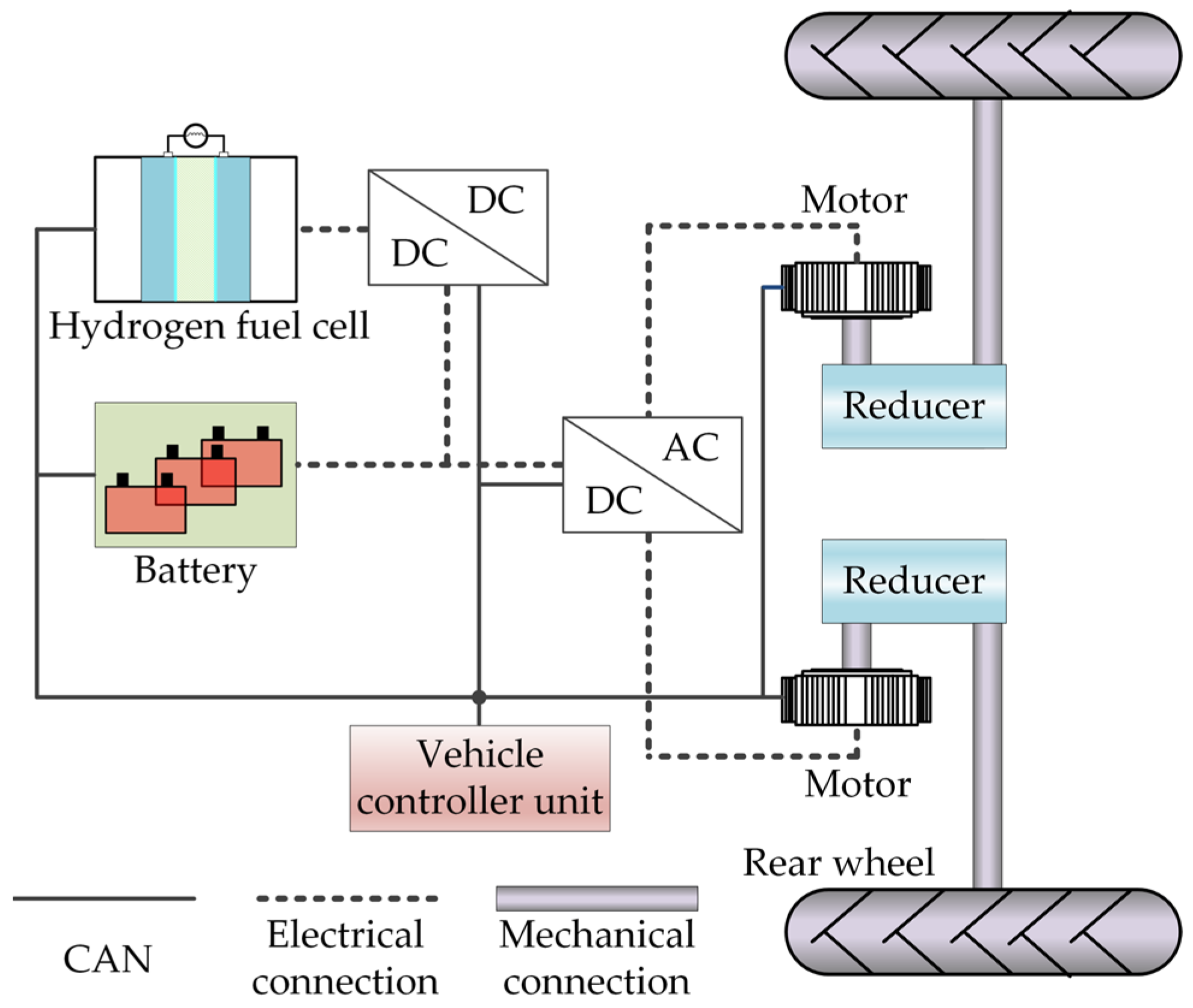
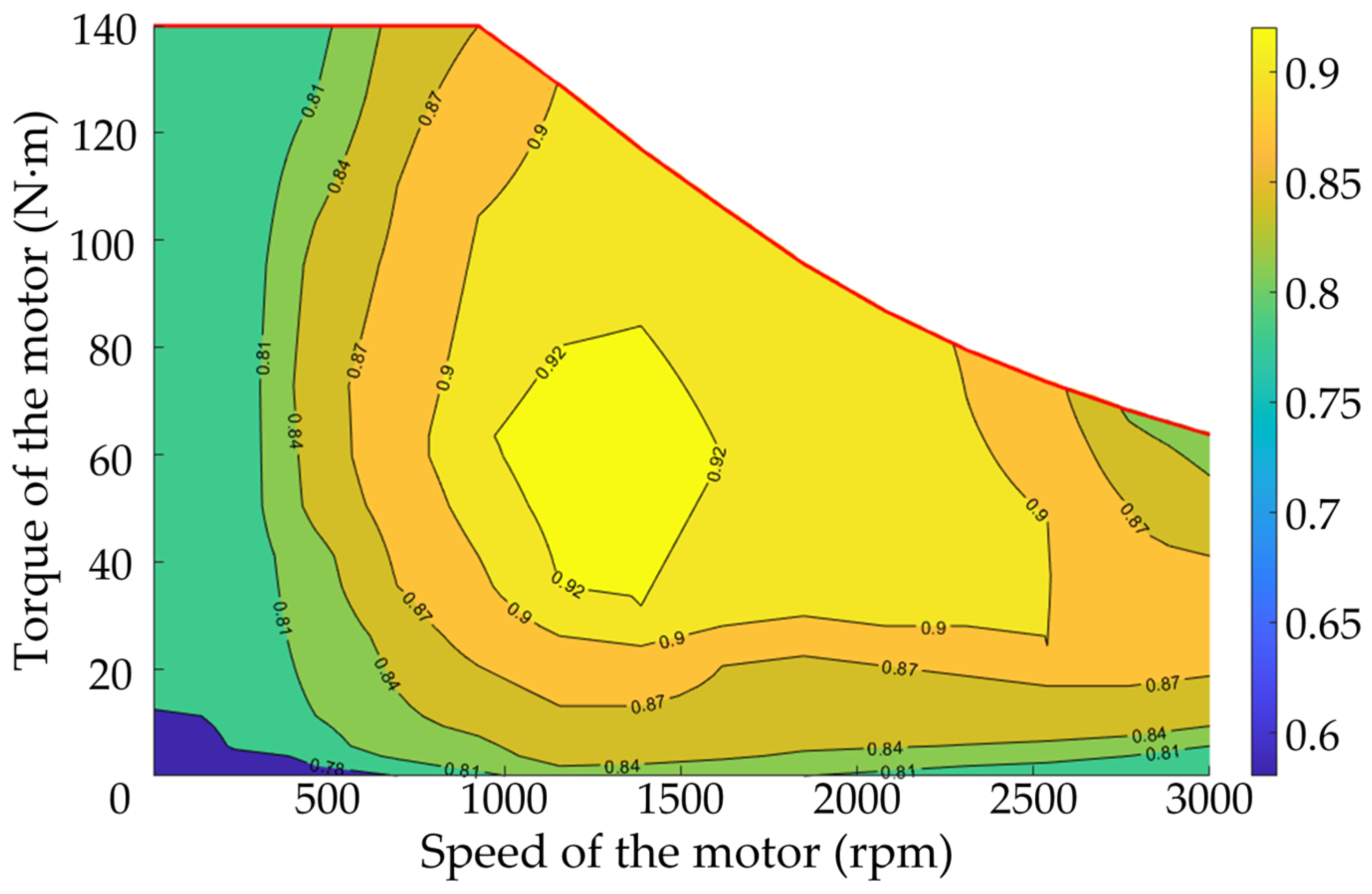



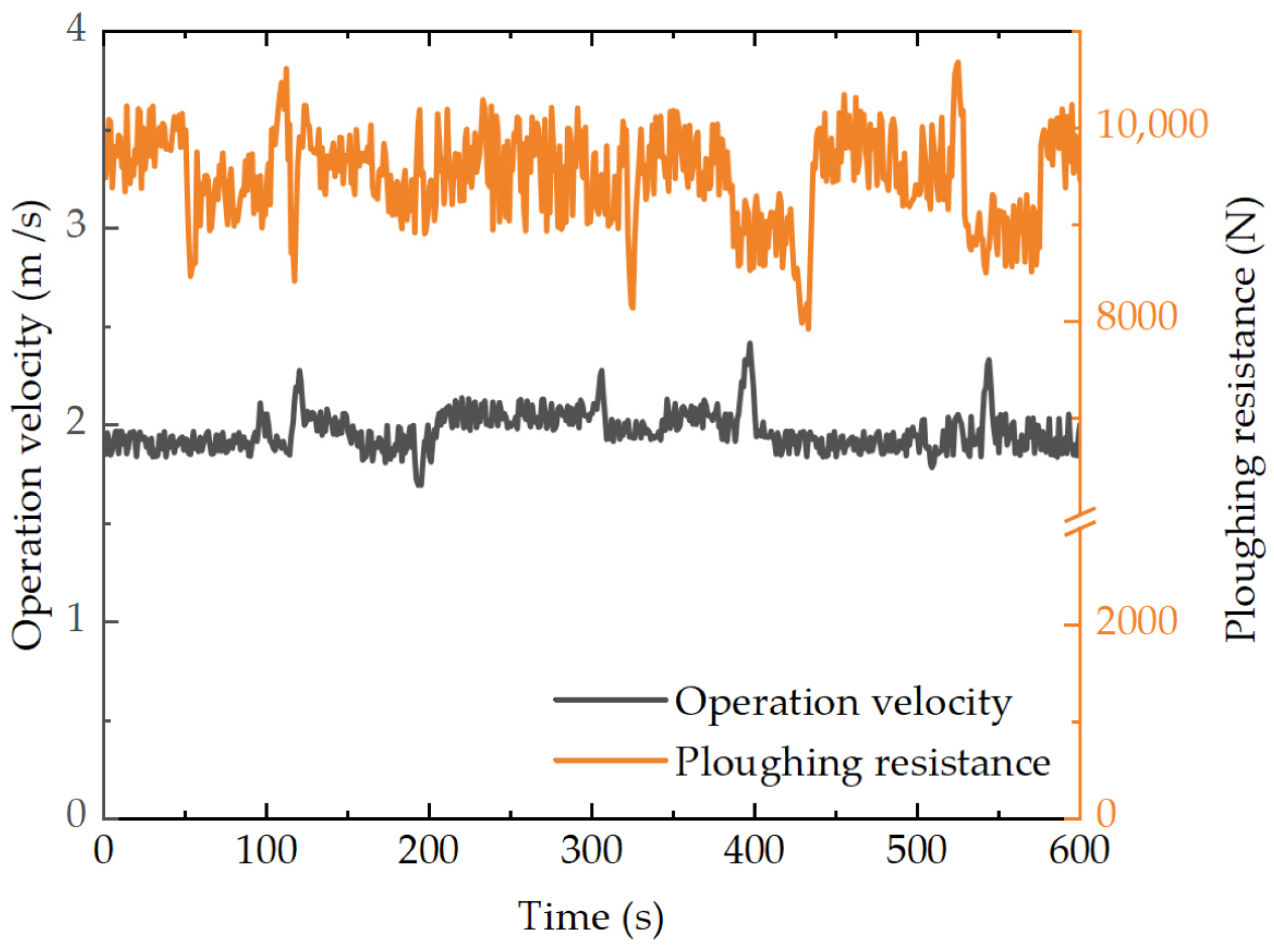
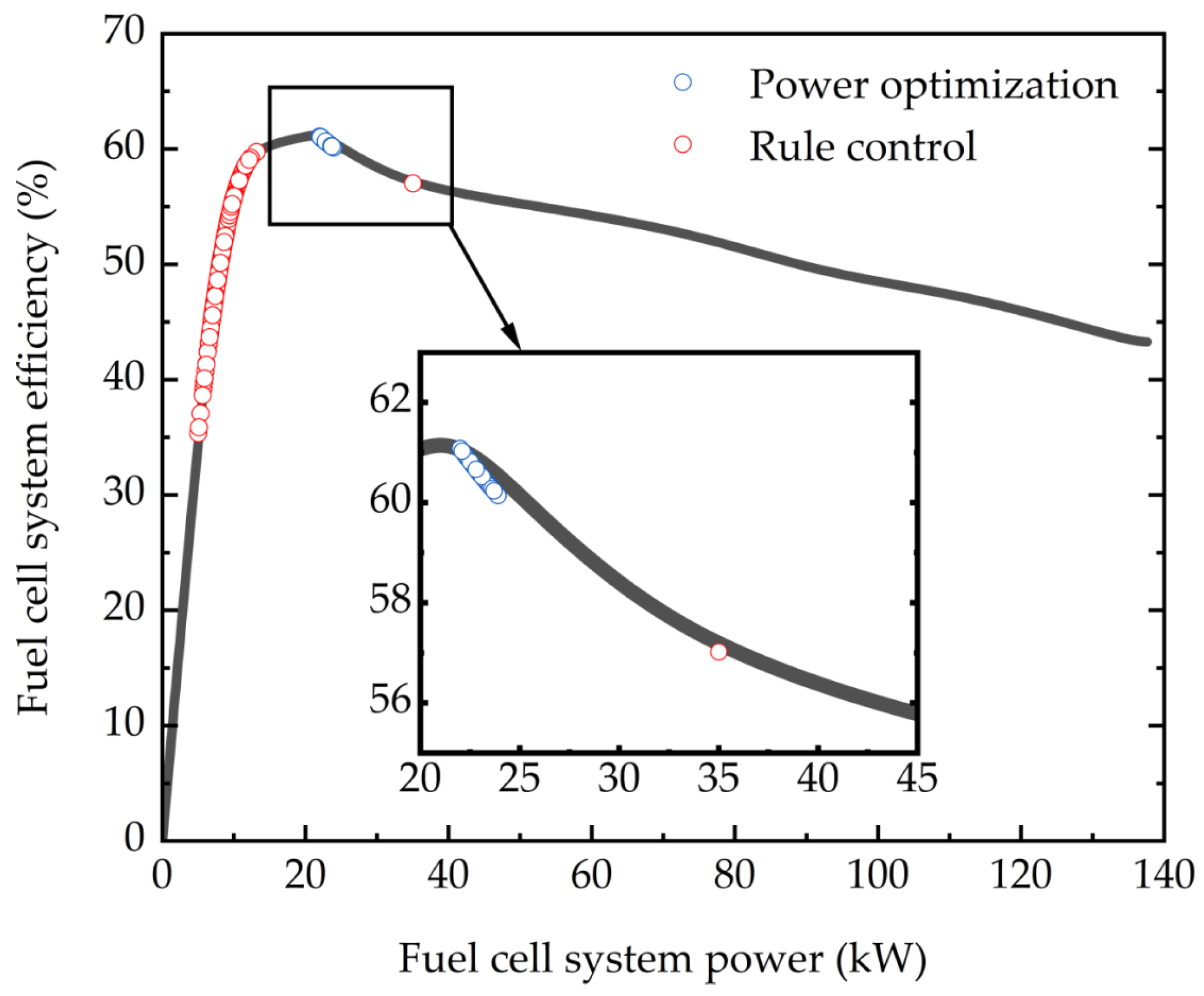
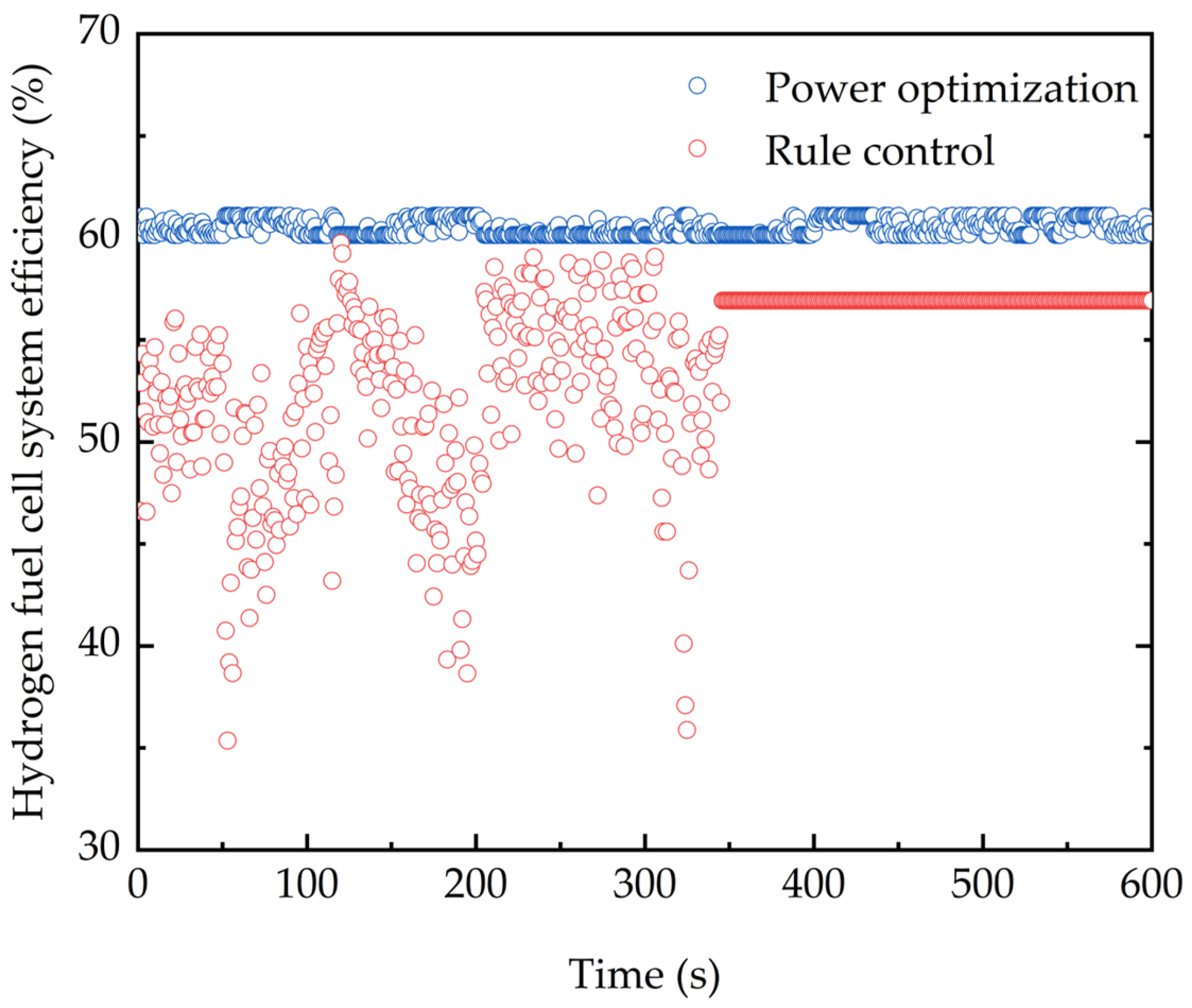
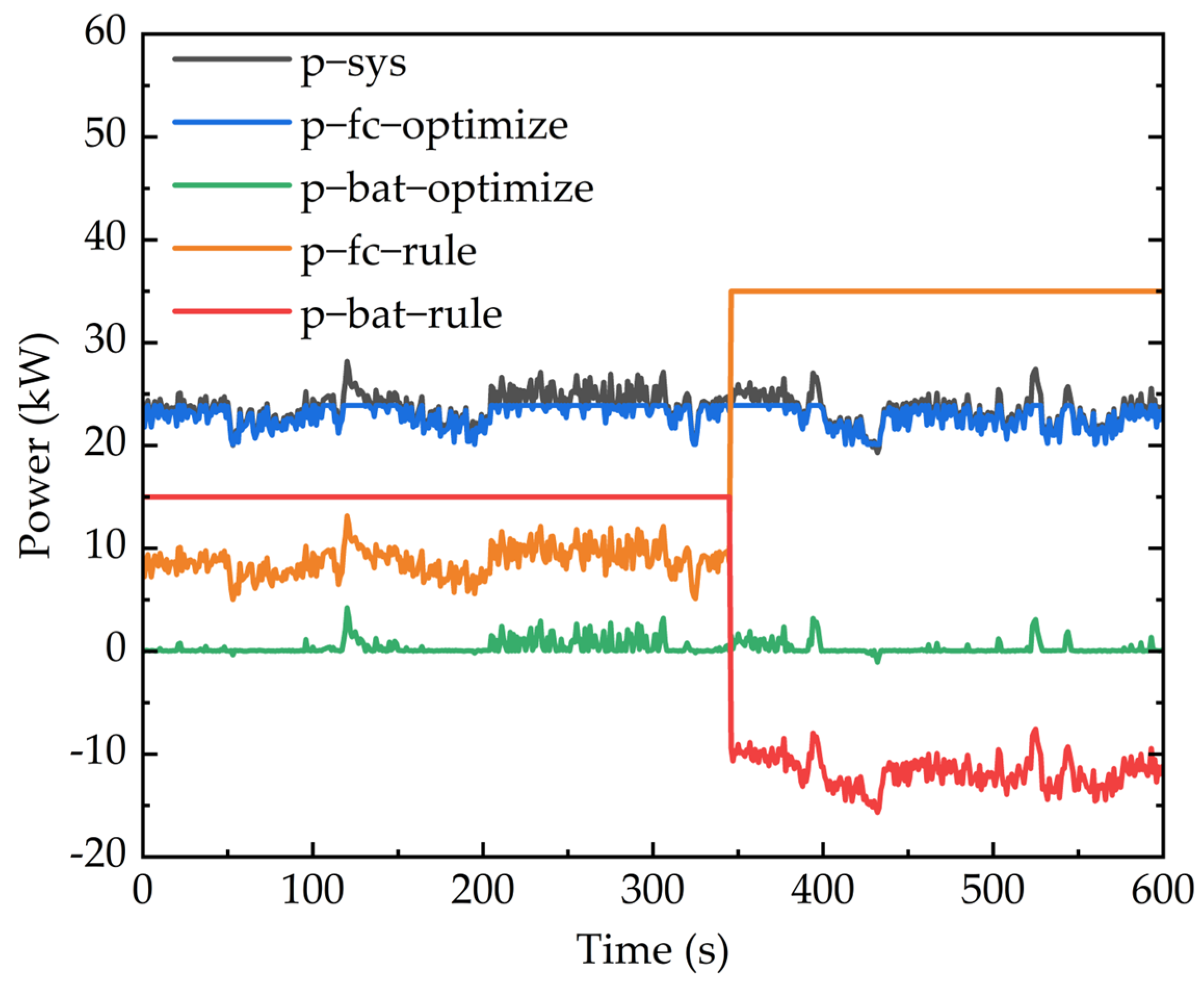

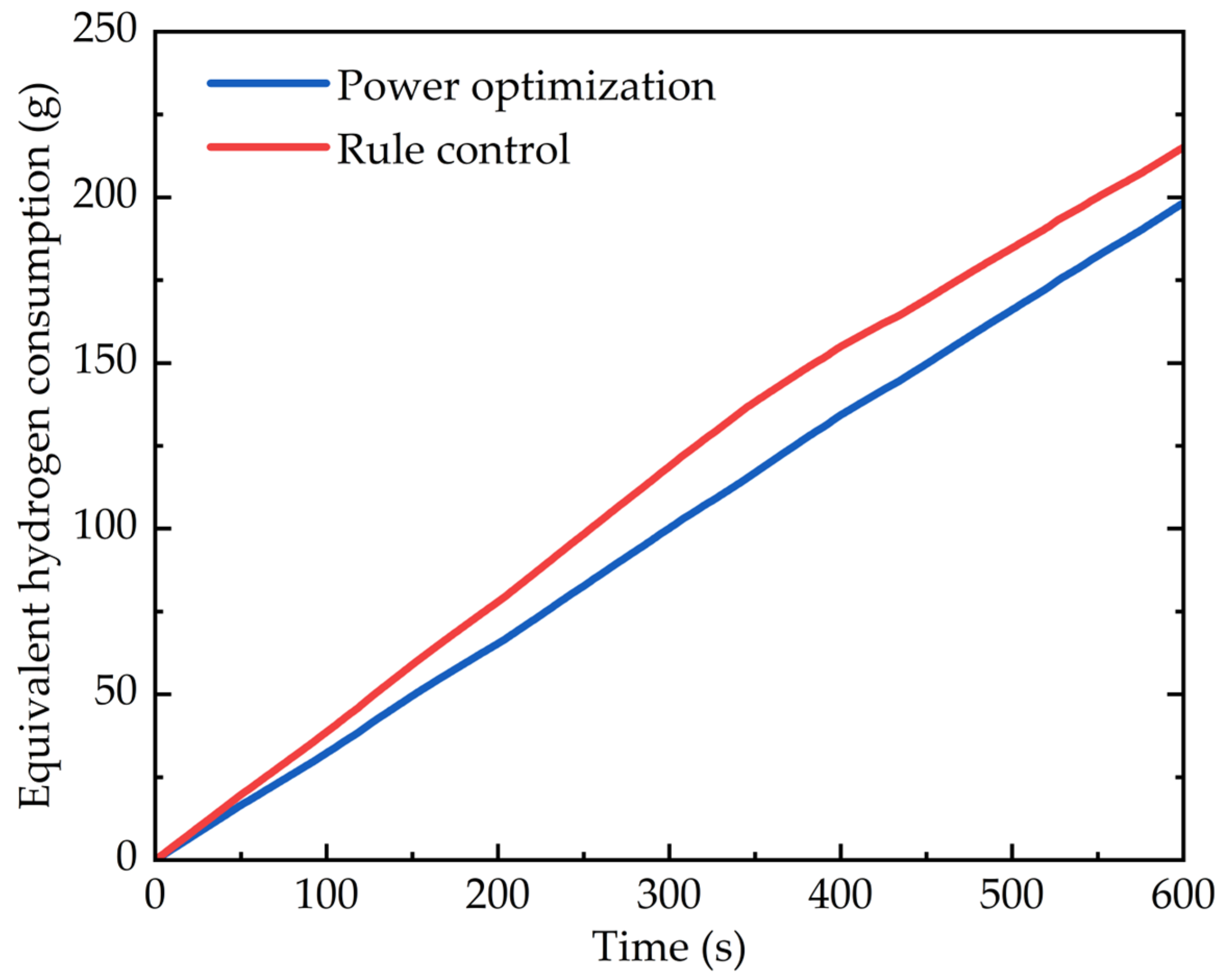
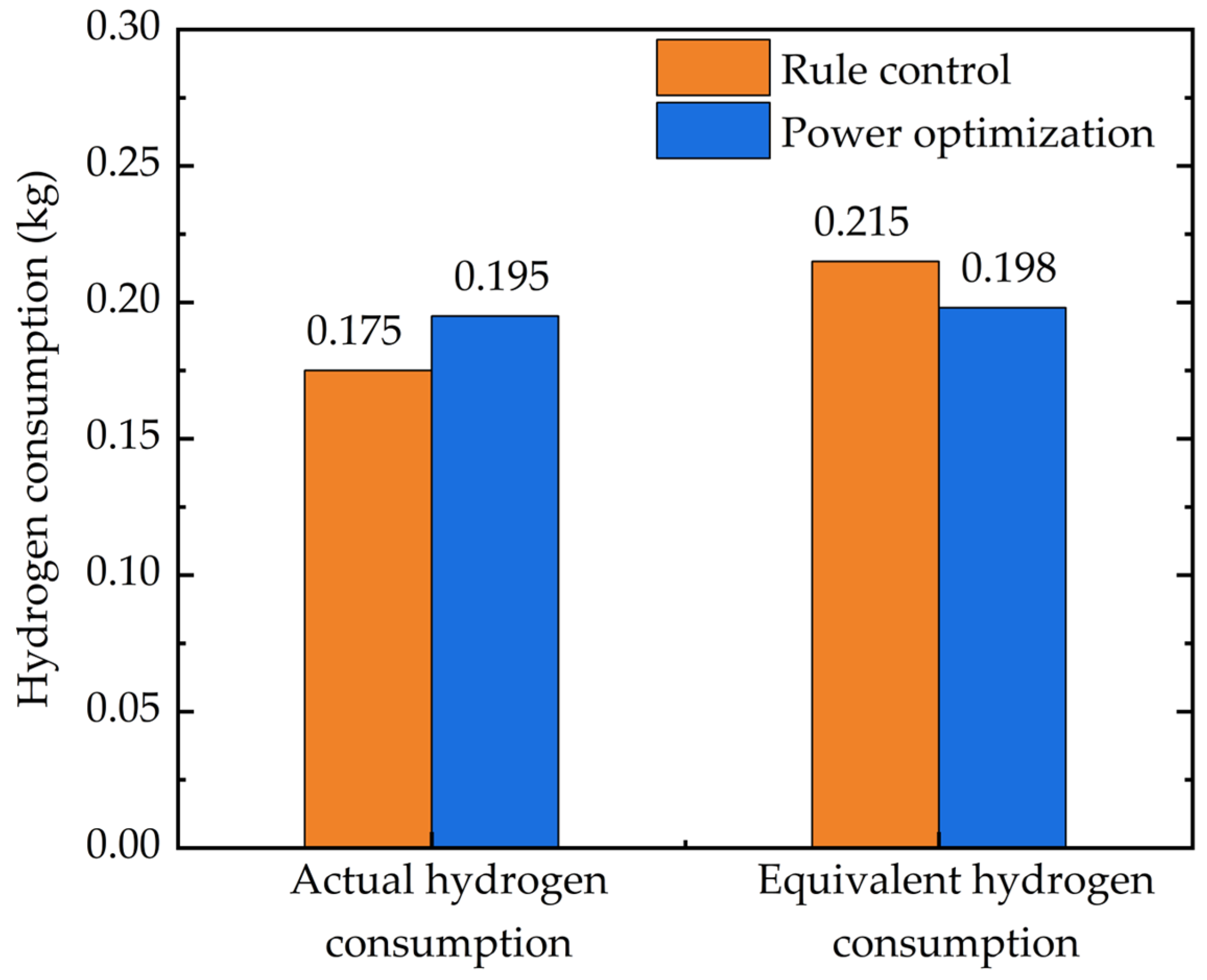
| Project | Parameters/Units | Value |
|---|---|---|
| Vehicle parameters | Tractor mass (kg) | 2500 |
| Driving wheel rolling radius (m) | 0.63 | |
| Rolling resistance coefficient | 0.07 | |
| Reducer speed ratio | 17 | |
| Motor | Rated speed (rpm) | 1500 |
| Rated torque (N·m) | 140 | |
| Rated power (kW) | 22 | |
| Power System | Energy capacity (kW·h) | 41 |
| Battery voltage (V) | 380 | |
| Battery capacity (A·h) | 108 |
Disclaimer/Publisher’s Note: The statements, opinions and data contained in all publications are solely those of the individual author(s) and contributor(s) and not of MDPI and/or the editor(s). MDPI and/or the editor(s) disclaim responsibility for any injury to people or property resulting from any ideas, methods, instructions or products referred to in the content. |
© 2024 by the authors. Licensee MDPI, Basel, Switzerland. This article is an open access article distributed under the terms and conditions of the Creative Commons Attribution (CC BY) license (https://creativecommons.org/licenses/by/4.0/).
Share and Cite
Zhang, J.; Wang, B.; Zhang, J.; Xu, L.; Zhang, K. Research on Power Optimization for Energy System of Hydrogen Fuel Cell Wheel-Driven Electric Tractor. World Electr. Veh. J. 2024, 15, 188. https://doi.org/10.3390/wevj15050188
Zhang J, Wang B, Zhang J, Xu L, Zhang K. Research on Power Optimization for Energy System of Hydrogen Fuel Cell Wheel-Driven Electric Tractor. World Electric Vehicle Journal. 2024; 15(5):188. https://doi.org/10.3390/wevj15050188
Chicago/Turabian StyleZhang, Jingyun, Buyuan Wang, Junjiang Zhang, Liyou Xu, and Kai Zhang. 2024. "Research on Power Optimization for Energy System of Hydrogen Fuel Cell Wheel-Driven Electric Tractor" World Electric Vehicle Journal 15, no. 5: 188. https://doi.org/10.3390/wevj15050188





